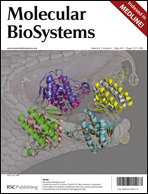Proteomics and high throughput analysis for systems biology can benefit significantly from solid-phase chemical tools for affinity pull-down of proteins from complex mixtures. Here we report the application of solid-phase synthesis of phosphopeptides for pull-down and analysis of the affinity profile of the integrin-linked kinase associated phosphatase (ILKAP), a member of the protein phosphatase 2C (PP2C) family. Phosphatases can potentially dephosphorylate these phosphopeptide substrates but, interestingly, performing the binding studies at 4 °C allowed efficient binding to phosphopeptides, without the need for phosphopeptide mimics or phosphatase inhibitors. As no proven ILKAP substrates were available, we selected phosphopeptide substrates among known PP2Cδ substrates including the protein kinases: p38, ATM, Chk1, Chk2 and RSK2 and synthesized directly on PEGA solid supports through a BAL type handle. The results show that phosphopeptides tethered to a flexible solid support bind with high affinity and specificity to ILKAP, which is pulled down from lysates of cells transfected with ILKAP cDNA. Phosphorylation on Ser or Thr residues is important for binding of ILKAP, but sequences around the phosphorylated residue are important for the binding affinity of ILKAP. We conclude that solid-phase affinity pull-down of proteins from complex mixtures can be applied in phosphoproteomics and systems biology.

You have access to this article
 Please wait while we load your content...
Something went wrong. Try again?
Please wait while we load your content...
Something went wrong. Try again?


 Please wait while we load your content...
Please wait while we load your content...